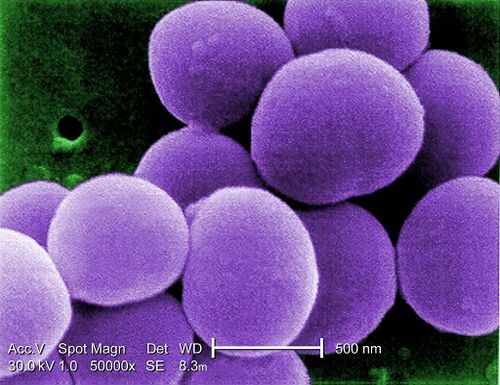Vancomycin-Resistant Staphylococcus Aureus (VRSA)
This article or area is currently under construction and may only be partially complete. Please come back soon to see the finished work! (6/01/2022)
Introduction[edit | edit source]
Bacteria may sometimes evolve to become resistant to antibiotics. Whenever this occurs, these new bacteria are called "antibiotic resistant". Over time, staph bacterial have become difficult to treat with certain types of antibiotics, including vancomycin and methicillin.[1] Vancomycin-resistant Staphylococcus aureus (VRSA) is a type of antimicrobial-resistant bacteria.[2]
Vancomycin-intermediate S. aureus (VISA) bacteria are moderately resistant to antibiotics, while VRSA bacteria are strongly resistant to antibiotics.[1]
Pathological Process[edit | edit source]
Staphylococcus aureus, also known as "staph", is a common type of bacteria that is often found on the skin and in the nose of healthy, asymptomatic people.[1]
VRSA bacteria are spread by direct person-to-person contact, usually on hands. VRSA bacteria may also spread by contact with VRSA-contaminated items, such as bandages, medical equipment, or surfaces. VRSA exposure does not guarantee illness. People who have been exposed to VRSA bacteria may carry the bacteria on their skin or in their nose and may not get sick at all, or may get sick from VRSA days, weeks, or months later.[1]
Risk Factors[edit | edit source]
Patients with the following conditions are at higher risk for VRSA infection:[1]
- Co-morbid conditions (ex. diabetes or kidney disease)
- Previous infection with MRSA
- Recent hospitalization
- Tubes going into the body (ex. catheter)
- Recent use of vancomycin or other antibiotics
Clinical Presentation[edit | edit source]
Diagnostic Procedures[edit | edit source]
Staph bacteria is identified as VRSA based on laboratory testing. These tests determine the minimum inhibitory concentration (MIC) of an antimicrobial agent that inhibit the Staph bacteria growth. Staph bacteria are classified as VRSA if the MIC is ≥16μg/mL.[2]
Management / Interventions
[edit | edit source]
If a patient suspects they have a VRSA infection or has been exposed to VRSA, they should immediately contact their healthcare provider.
As of 2010, VRSA is treatable with several FDA-approved drugs. [2]
Prevention[edit | edit source]
Use of personal protective equipment (PPE) and appropriate hand hygiene by healthcare personnel can reduce the spread of VRSA.[2]
References[edit | edit source]
- ↑ 1.0 1.1 1.2 1.3 1.4 https://www.vdh.virginia.gov/epidemiology/epidemiology-fact-sheets/vancomycin-intermediate-staphylococcus-aureus-visa-and-vancomycin-resistant-staphylococcus-aureus-vrsa-infections/?TSPD_101_R0=5b67e3c62340690422428653d26c0331v500000000000000000c73c106cffff000000000000000000000000000061d7461400b5bf837508a442c88dab2000285a6d2e016d91363242431de1ecef2901c747187b70441b18c8b646ce1c3c2808a3fca0230a2800a4557575aea6cc3042c56a5bface216f3122e7cd49a522be9ebeac071b6e748c19a967ef67592485
- ↑ 2.0 2.1 2.2 2.3 https://www.cdc.gov/hai/organisms/visa_vrsa/visa_vrsa.html







